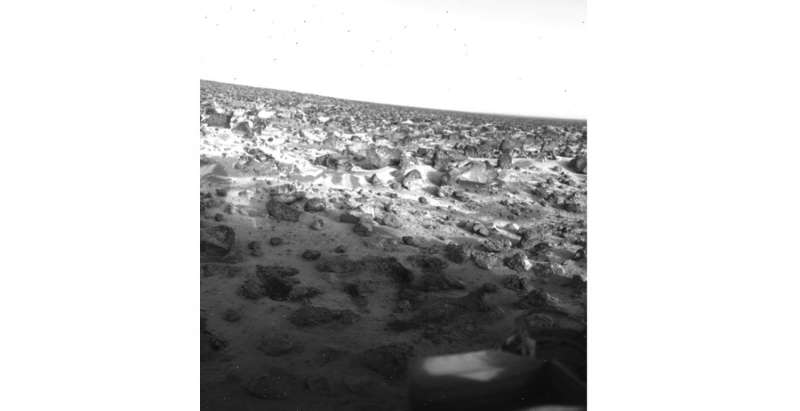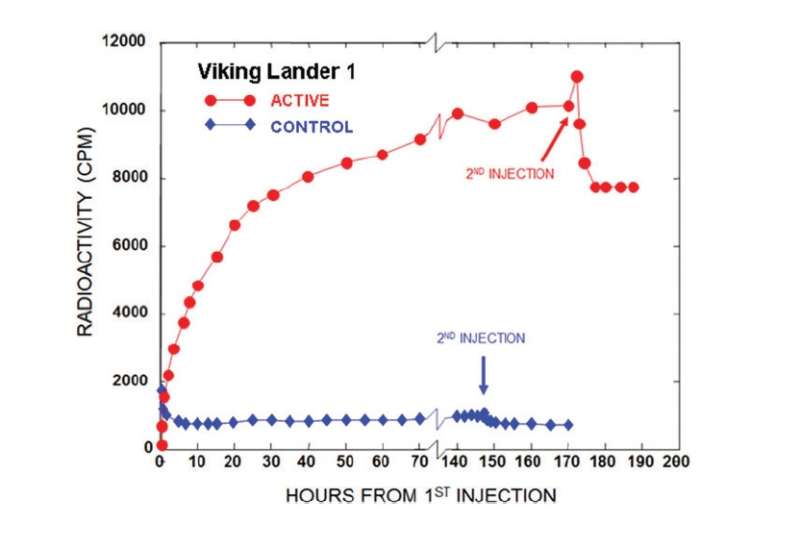Viking Found Again on Mars by Rover

(Phys.org)—In 1976, two Viking landers became the first Us spacecraft from Earth to touch down on Mars. They took the showtime loftier-resolution images of the planet, surveyed the planet's geographical features, and analyzed the geological composition of the atmosphere and surface. Perhaps most intriguingly, they too performed experiments that searched for signs of microbial life in Martian soil.
Overall, these life-detection experiments produced surprising and contradictory results. 1 experiment, the Labeled Release (LR) experiment, showed that the Martian soil tested positive for metabolism—a sign that, on Earth, would almost certainly suggest the presence of life. All the same, a related experiment found no trace of organic material, suggesting the absenteeism of life. With no organic substances, what could exist, or seem to be, metabolizing?
In the twoscore years since these experiments, scientists take been unable to reconcile the conflicting results, and the general consensus is that the Viking landers found no conclusive bear witness of life on Mars. However, a modest minority of scientists argues that the Viking results were positive for life on Mars.
One prominent proponent of this view is Gilbert Levin, Experimenter of the Viking LR experiment. At first, Levin thought that the LR results were unclear, and stated simply that the results were consistent with biology. However, in 1997, after many years of further experiments on Earth, along with new discoveries on Mars (which NASA has now declared "habitable"), and the discovery of microorganisms living under conditions on Globe every bit astringent as those on Mars, he and his Viking Co-Experimenter, Dr. Patricia A. Straat, have argued that the Mars results are best explained past living organisms.
Recently, Levin and Straat published a perspective piece in the periodical Astrobiology in which they reconsider the results of the Viking LR experiment in lite of contempo findings on Mars and recent proposals for inorganic substances that may mimic the observed metabolism-like processes. They argue that none of the proposed abiotic substances sufficiently explains the Viking results, and that Martian microbes should still exist considered equally the best explanation of the results.
How the Labeled Release experiment worked
In the LR experiment, both the Viking 1 and Viking 2 landers nerveless samples of Martian soil, injected them with a drib of dilute nutrient solution, and then monitored the air above the soil for signs of metabolic byproducts. Since the nutrients were tagged with radioactive carbon-14, if microorganisms in the soil metabolized the nutrients, they would be expected to produce radioactive byproducts, such every bit radioactive carbon dioxide or methane.
Earlier launching the Viking spacecraft, the researchers tested the experimental protocol on a broad diversity of terrestrial soils from harsh environments, from Decease Valley to Antarctica. In each example, the experiments tested positive for life. Then every bit a control, the researchers heated the samples to 160 °C to kill all lifeforms, and and so retested. In each case, the experiments at present tested negative. To further confirm that the experimental procedure would not produce fake positives, the researchers tested it on soils known to be sterile, such as those from the Moon and the Surtsey volcanic island near Iceland, which produced negative results as expected.
Once on Mars, the LR experiment was performed afterwards the experiment searching for organic molecules came up empty-handed. So it came as a surprise when both Viking landers, located 4,000 miles autonomously, collected soil that tested positive for metabolism. To rule out the possibility that the potent ultraviolet radiation on Mars might be causing the positive results, the landers nerveless soil buried underneath a rock, which once again tested positive. The command tests too worked, with the 160 °C sterilization control yielding negative results.
In addition, it seemed that any was doing the metabolizing was relatively fragile, since metabolic activeness was significantly reduced when heating the sample to fifty °C, and completely absent-minded when storing the soil in the dark for ii months at x °C. Levin and Straat believe that these results provide some of the strongest evidence that the soil contained Martian life.
Nonbiological candidates
Ever since the LR experiments, researchers have been searching for other kinds of nonbiological chemicals that might produce identical results.
In their new newspaper, Levin and Straat review some of these proposals. One possible candidate is formate, which is a component of formic acrid found naturally on Earth. A 2003 LR-type experiment found that formate in a soil sample from the Atacama Desert in South America produced a positive issue, fifty-fifty though the soil contained well-nigh no microorganisms. However, the study did not include a sterilization control, and it'due south likely that the formate concentration in the Atacama Desert is much higher than that on Mars.
Another potential candidate is perchlorate or 1 of its breakup products. In 2009, the Phoenix mission to Mars detected perchlorates in the Martian soil. Although perchlorates could yield a positive result because they produce gas when interacting with some amino acids, they do non break down at 160 °C, and then would continue to give positive results after the sterilization control.
A 2013 written report proposed that cosmic rays and solar radiation can cause perchlorate to intermission downward into hypochlorite, which would produce positive results and, unlike perchlorate, is destroyed by heating at 160 °C. For these reasons, hypochlorite is arguably the all-time candidate however to explain the LR results.
All the same, Levin and Straat annotation that hypochlorite has not yet been tested at fifty °C (the temperature at which the activity of the Martian soil was significantly reduced) or later on long-term storage in the nighttime (which produced a negative result for the Martian samples). And so at this point, no nonbiological agent has satisfied all of the LR results.
Biological candidates

Today researchers know much more about Mars than they did twoscore years ago. One of the biggest discoveries came in 2014, when the Mars Scientific discipline Laboratory Curiosity rover detected the presence of organic molecules on Mars for the first time.
Over the past two years, Curiosity's onboard Sample Analysis at Mars (SAM) laboratory has detected methane, chlorinated hydrocarbons, and other organic molecules. Researchers suspect that these organic substances may have formed on Mars or been carried at that place by meteorites.
The discovery of organic matter on Mars raises the question of why the Viking experiment did non observe organic affair back in 1976. Equally Levin explains, there are multiple reasons that might explain why the Viking results were negative.
"Nosotros long ago pointed out the issues with the Viking GCMS (gas chromatograph—mass spectrometer)," Levin said. "Fifty-fifty its experimenter, Dr. Klaus Biemann, ofttimes stressed that the GCMS was not a life-detection experiment. It required at to the lowest degree one million microbial cells to detect whatever organic matter. In improver, the instrument had often failed when tested on Earth. Later, it was claimed that perchlorate in the soil destroyed the organic matter. However, I view this charily as there is no evidence for perchlorate at the Viking sites."
In calorie-free of the recent findings, Levin and Straat believe that it'south important to reconsider the LR results every bit having a biological origin. Other researchers who support this view have proposed that Martian life could take the class of methanogens (microorganisms that produce methane every bit a byproduct), halophiles (which can tolerate loftier table salt concentrations as well as severe radiations and low oxygen concentrations), or some blazon of "cryptobiotic" microorganism that lies dormant until reactivated, such equally by a food solution similar the one in the LR experiment.
Publishing challenges
Publishing a paper near life on Mars was very different than publishing more than typical studies (over the years, Levin'southward research has included low-calorie sweeteners, pharmaceutical drugs, safer pesticides, and wastewater treatment processes, amid others). Information technology took nearly xx years for Levin and Straat to publish a peer-reviewed newspaper on their interpretation of the Viking LR results.
"Since I outset concluded that the LR had detected life (in 1997), major juried journals had refused our publications," Levin told Phys.org. "I and my co-Experimenter, Dr. Patricia Ann Straat, and so published mainly in the astrobiology section of the SPIE Proceedings, after presenting the papers at the annual SPIE conventions. Though these were invited papers, they were largely ignored by the bulk of astrobiologists in their publications." These papers are available at gillevin.com.
"At a coming together of the Canadian Infinite Agency, I met Dr. Sherry Cady, the editor of Astrobiology. She invited me to submit a paper for peer review. I did and it was promptly bounced, non even sent out for review because of its life claim.
"Pat and I decided nosotros would produce a newspaper that would withstand the utmost scientific scrutiny. It took years of countless renditions and compliance with or explanation away of a myriad of reviewers' comments, but we persisted until nosotros tending of every adverse annotate. Thus, we think this publication is quite pregnant in that it was scrubbed so thoroughly that the points remaining are firmly established.
"You may not concur with the conclusion, but you cannot disparage the steps leading at that place. You can say only that the steps are insufficient. But, to us, that seems a tenuous defence force, since no ane would abnegate these results had they been obtained on Earth."
Hereafter outlook
For Levin and Straat, i of the most important reasons for considering the being of life on Mars is a practical one that may impact future enquiry.
"It seems prudent that the scientific community maintain biology as a viable explanation of the LR experimental results," they write in their paper. "It seems inevitable that astronauts will eventually explore Mars. In the involvement of their health and rubber, biology should be held in the forefront of possible explanations for the LR results."
Going forwards, Levin and Straat propose that carefully designed experiments can help to answer the question of the existence of life on Mars. In particular, LR-type experiments that examination for chiral preference could tell whether the metabolizing substance is biological or chemical, since only biological agents can distinguish between left and correct isomers. The scientists also emphasize the importance of the continued search for organic molecules, particularly those with biological significance such as amino acids, unproblematic carbohydrates, lipids, proteins, and DNA. Futurity experiments may as well provide the possibility of examining Martian soil nether a microscope.
Despite the positive outlook, Levin and Straat note that all time to come experiments will have an unavoidable drawback: the potential for contagion by previous landers. In this regard, the Viking landers were unique in that they were the only pristine Martian life-detection experiment that we volition ever have.
More information: Gilbert V. Levin and Patricia Ann Straat. "The Case for Extant Life on Mars and Its Possible Detection past the Viking Labeled Release Experiment." Astrobiology. Oct 2016, 16(10): 798-810. DOI: 10.1089/ast.2015.1464
© 2016 Phys.org
Citation: Did xl-year-old Viking experiment discover life on Mars? (2016, Oct 21) retrieved xviii March 2022 from https://phys.org/news/2016-10-year-old-viking-life-mars.html
This document is subject to copyright. Autonomously from any fair dealing for the purpose of private study or research, no part may exist reproduced without the written permission. The content is provided for information purposes only.
Source: https://phys.org/news/2016-10-year-old-viking-life-mars.html
0 Response to "Viking Found Again on Mars by Rover"
Postar um comentário